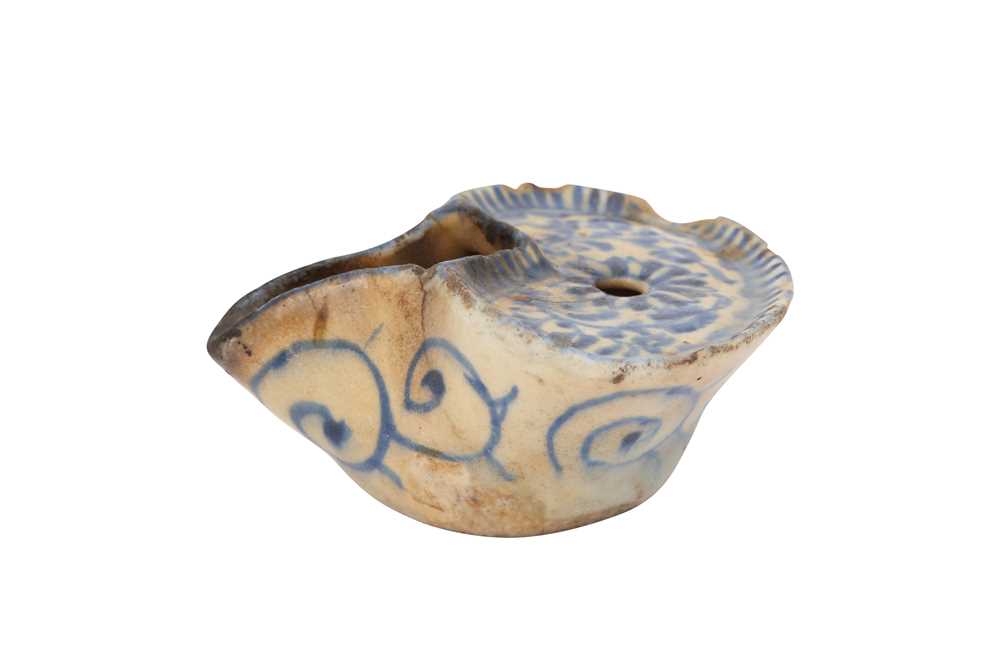A SAFAVID BLUE AND WHITE GOMBROON POTTERY EWER Iran, 17th century Of compressed globular form with faceted sides, on straight circular foot, rising to a tall cylindrical neck with domed mouth, a faceted tapering spout, the body, shoulder and mouth decorated with foliate mouldings and painted in underglaze cobalt blue, the decoration on the body consisting of roundels of floral and scale patterning, mounted with a curved metal handle decorated with bands of flowerheads and scrolls, 20cm high. Provenance: The Late Henri d’Allemagne (d. 1950) Collection. Offered at Sotheby’s London (9 April 2008, ) and in the same vendor’s collection since, This delicate ewer presents numerous stylistic and decorative similarities with a Gombroon pottery ewer part of the V&A Museum collection (inv. no. 576-1889). In both cases, the fritware plain white body has been sufficiently vitrified to become very translucent. Foliate mouldings, reminiscent of leaves or petals, decorate the base of the neck and the area adjacent the handle and spout. The tapering faceted spout bends at the tip in a very elegant and subtle curve. In our case, the domed mouth and the trefoil lappets mouldings are rather unusual and seem to place the ewer in a small group of white wares which are thought to date around the late the seventeenth century. Although often confusing and vague, the term “Gombroon pottery” has been recurrently used in past to group the production of 17th to 18th-century Iranian ceramics characterised by very fine hard white bodies, usually pierced or incised, and heavily vitrified. Their translucency has often been considered a quintessential feature. The term “Gombroon” itself is the European name for Bandar-e Abbas, the main trading port on the Persian Gulf, from where most likely these ceramics were exported to Europe at the end of 17th century when Chinese export porcelain production started fading. (O.Watson, Ceramics from Islamic Lands, London, 2004, p. 478). According to John Fryer (d. 1733), the writer of A New Account of East India and Persia being nine years’ travels, 1672-1681, 1698, ‘Gombroon ware made of earth, the best next China’. However, the term may have been used to describe Iranian fritwares in general, rather than this specific group (V&A Museum Online Collection: http://collections.vam.ac.uk/item/O185857/ewer-unknown/).
A SAFAVID BLUE AND WHITE GOMBROON POTTERY EWER Iran, 17th century Of compressed globular form with faceted sides, on straight circular foot, rising to a tall cylindrical neck with domed mouth, a faceted tapering spout, the body, shoulder and mouth decorated with foliate mouldings and painted in underglaze cobalt blue, the decoration on the body consisting of roundels of floral and scale patterning, mounted with a curved metal handle decorated with bands of flowerheads and scrolls, 20cm high. Provenance: The Late Henri d’Allemagne (d. 1950) Collection. Offered at Sotheby’s London (9 April 2008, ) and in the same vendor’s collection since, This delicate ewer presents numerous stylistic and decorative similarities with a Gombroon pottery ewer part of the V&A Museum collection (inv. no. 576-1889). In both cases, the fritware plain white body has been sufficiently vitrified to become very translucent. Foliate mouldings, reminiscent of leaves or petals, decorate the base of the neck and the area adjacent the handle and spout. The tapering faceted spout bends at the tip in a very elegant and subtle curve. In our case, the domed mouth and the trefoil lappets mouldings are rather unusual and seem to place the ewer in a small group of white wares which are thought to date around the late the seventeenth century. Although often confusing and vague, the term “Gombroon pottery” has been recurrently used in past to group the production of 17th to 18th-century Iranian ceramics characterised by very fine hard white bodies, usually pierced or incised, and heavily vitrified. Their translucency has often been considered a quintessential feature. The term “Gombroon” itself is the European name for Bandar-e Abbas, the main trading port on the Persian Gulf, from where most likely these ceramics were exported to Europe at the end of 17th century when Chinese export porcelain production started fading. (O.Watson, Ceramics from Islamic Lands, London, 2004, p. 478). According to John Fryer (d. 1733), the writer of A New Account of East India and Persia being nine years’ travels, 1672-1681, 1698, ‘Gombroon ware made of earth, the best next China’. However, the term may have been used to describe Iranian fritwares in general, rather than this specific group (V&A Museum Online Collection: http://collections.vam.ac.uk/item/O185857/ewer-unknown/).















Testen Sie LotSearch und seine Premium-Features 7 Tage - ohne Kosten!
Lassen Sie sich automatisch über neue Objekte in kommenden Auktionen benachrichtigen.
Suchauftrag anlegen